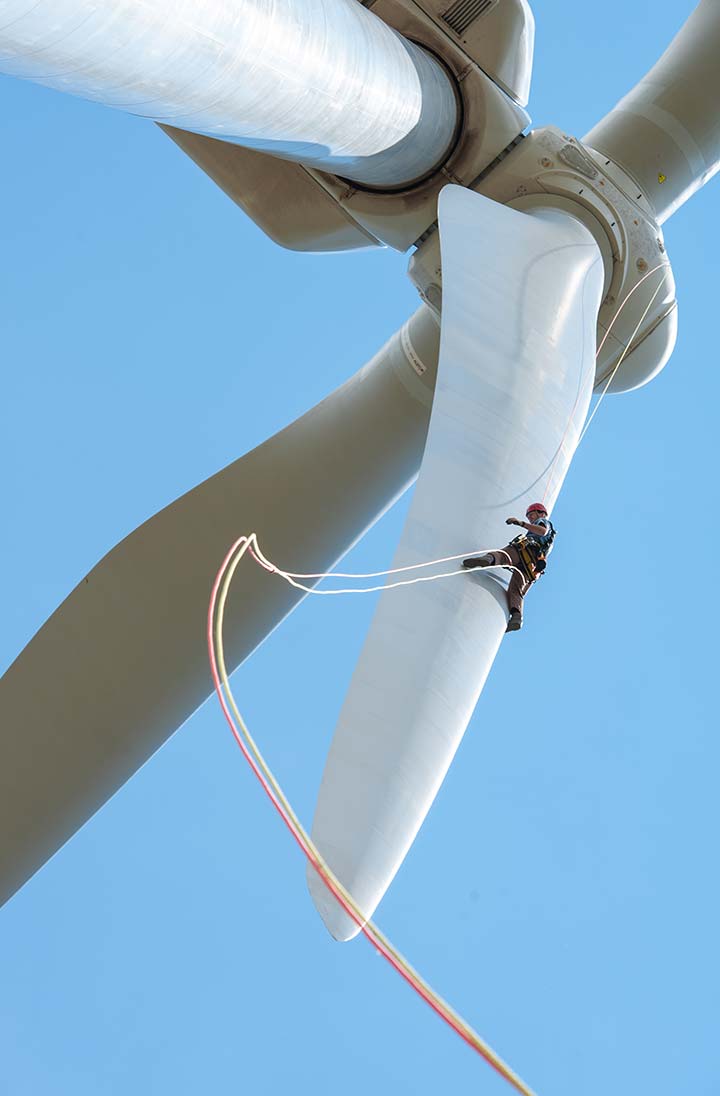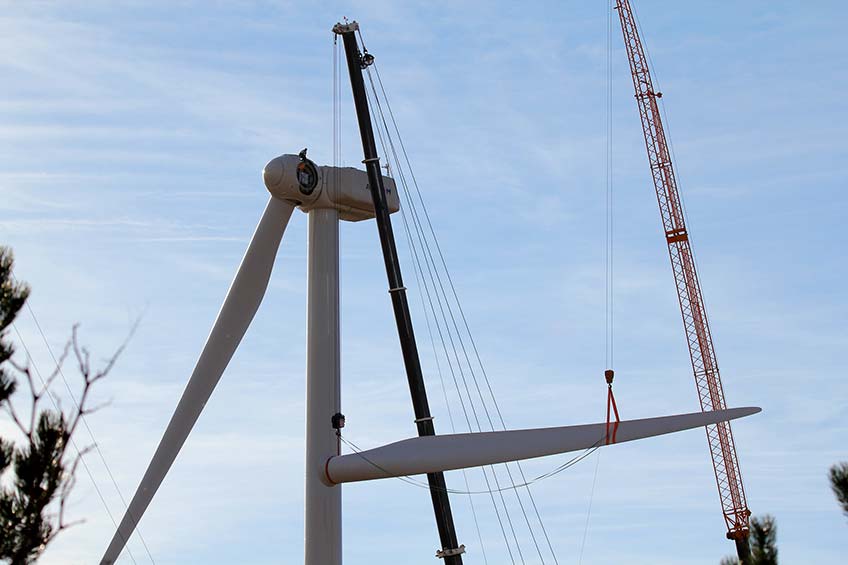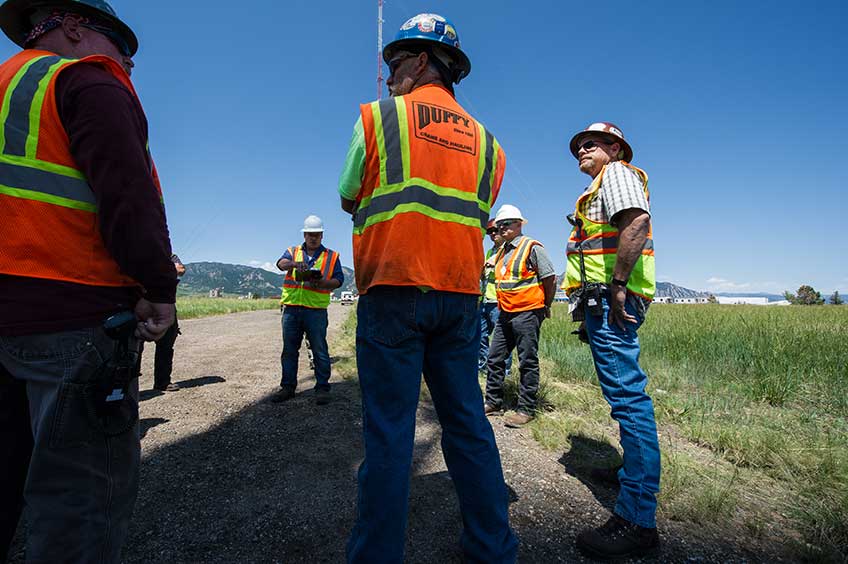Research Turbine Leaves Legacy in Its Wake
The conclusion of a successful multiyear industry partnership will soon alter the landscape for Denver-area residents. This month, GE will remove the largest of the megawatt-scale research turbines at the National Wind Technology Center (NWTC) at the National Renewable Energy Laboratory (NREL), located near Boulder, Colorado. In addition to hosting VIPs and winning a photo competition, the 3-megawatt (MW) GE wind turbine has aided eight years of research and development at the laboratory.

The collaboration began in January of 2010 when Alstom, which was later acquired by GE, approached NREL about entering into a two-year agreement for validation and drivetrain research on the company's turbine. NREL Principal Engineer and Project Manager Jeroen van Dam worked with Anne Miller to get a signed cooperative research and development agreement (CRADA) in place before the end of May, just in time for an announcement at the industry's largest annual conference.
"It was very good timing," said Albert Fisas, a wind advanced technology manager at GE who helped establish the CRADA. "We were looking for a location that could accommodate a 3-MW turbine, and NREL had a pad available. As important as that, we knew that working with NREL on certification would also open the doors for deeper technology collaboration."
NREL's validation capabilities are accredited by the American Association for Laboratory Accreditation, which enables turbine manufacturers and wind power plant developers to meet requirements established by wind turbine certification agencies, financial institutions, and other oversight organizations worldwide. The 305-acre NWTC can evaluate turbines' mechanical loads, power performance, acoustic noise emissions, and safety and function. The turbines on site are not intended for power production. Rather, they are research labs in the sky.
The Alstom 3-MW ECO 100, named for the total 100-meter swept diameter covered by its rotor, was installed at the NWTC starting in October 2010 and commissioned at full operating capacity in April 2011. NREL and Alstom worked shoulder to shoulder to complete the certification testing required for commercial introduction of the 60-hertz unit in North America. NREL also obtained additional measurements of power performance, acoustic noise, and system frequency to complement results from a 50-hertz unit assessment previously completed in Europe.
"The first CRADA was a two-year agreement, but we have extended the collaboration more than 10 times," said Fisas. "That is a sign that things have gone far beyond the initial plans and expectations."
Over the years, the GE 3-MW turbine has stayed busy, collecting data as recently as January 2018. One of the most monumental efforts involved a rotor exchange that upgraded the turbine to an ECO 110. Two 340-foot cranes were needed to install the larger, 175-foot blades optimized for intermediate wind speeds.

Two cranes support the removal of a 100-m blade on the GE 3-MW wind turbine at the NWTC. (Photo by Lee Jay Fingersh, NREL)
According to van Dam, it will take nine lifts to get the GE 3-MW turbine totally removed. The process is very similar to installing a turbine, but in reverse. That means it will take about one week, weather depending, to remove the blades, then the nacelle, and finally the tower, section by section.
"Site reclamation was part of the initial task agreement, so the GE team will leave the site just as they found it," said van Dam. "The road will be partially pulled out, the foundation taken away, wiring removed, everything."
Some of the turbine's components will be used as spare parts, much of the steel will be recycled, and other elements will be retired after providing years of valuable data. The lasting legacy of the 3-MW GE turbine, though, extends beyond its physical presence at the NWTC.
"For me, this was the first turbine that I installed on the site," said van Dam. "A whole generation of engineers and technicians almost grew up with it in the sense that it brought a lot of firsts for people in the field."
Fisas agrees. "This turbine has facilitated dozens of engineers from Alstom and GE, both in Europe and the U.S., all learning from NREL staff."
Fisas and van Dam effortlessly list the names of several people involved in making the project successful, including NREL's Anne Miller, who helped put the initial agreement in place; Jerry Hur, who served as NREL's lead technician on the project; Jon Campbell, who served as a project manager for GE; and Fernando Ponce, who, as the GE site manager for multiple years, was "kind of the shadow of the turbine."
But the turbine's legacy extends beyond people. Another success worthy of the record books is the turbine's perfect safety record over thousands of working hours. Fisas emphasizes the point that GE and NREL have not just been operating the turbine, but also performing complex procedures—like changing out blades that weigh more than 10 tons—all while following NREL's safety protocols without a single issue.
"I'm sure during decommissioning, we will keep up that perfect safety record," said Fisas.

NREL's Don Young conducts a prelift safety meeting with NREL and Duffy Crane personnel before the lift of a lidar to the top of the GE turbine where it was used to validate advanced turbine control features. (Photo by Dennis Schroeder, NREL)
The turbine's technological impacts will also carry on after its removal. For example, researchers at NREL and their industry partners developed laser-based sensors and controls that can measure wind speed ahead of a turbine. This "look-ahead" information prepares the turbine's pitch actuators to respond before the wind reaches the blades, thereby reducing the impact of strong wind gusts and turbulence. This light detection and ranging (lidar) system was installed and tested on the 3-MW GE turbine.
"We were able to operate the turbine using the sensor and validate the capabilities of the lidar for a multimegawatt turbine," said Fisas. "Those lessons are being considered for a new 12-MW offshore turbine—four times the nominal power of this turbine—with a 220-meter rotor."
NREL currently has no plans to replace the turbine. However, the industry is growing as fast as its turbines. In 2016, wind capacity accounted for more than 40% of installed U.S. renewable electricity capacity. van Dam is optimistic that future partnerships will arise to take advantage of the meteorological conditions, world-class equipment, and deep staff expertise at the NWTC.
"We constantly get inquiries about whether we have space for prototype turbines, but the good spots are all taken," said van Dam. "With this one disappearing, I would imagine we will find another partner interested in placing a research and development turbine at the site."
Hinting at an emotional legacy, he adds, "But I will definitely miss it."
Last Updated May 28, 2025
